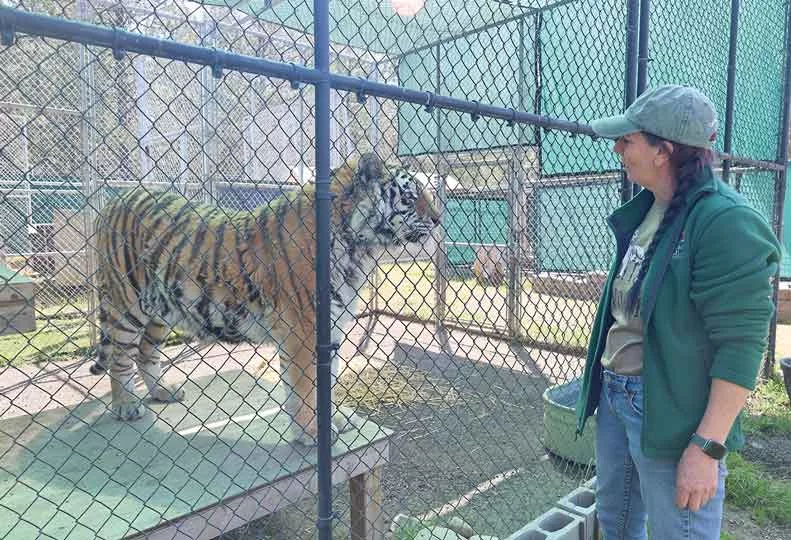What's Going on with: Cat Tales Wildlife Center
Organization shifts focus, with relocation remaining a long-term goal

Lisa Grey, executive director of Cat Tales Wildlife Center, greets Amura, a 15-year-old Siberian tiger.
| Karina EliasA year after unveiling a $146 million relocation plan, Cat Tales Wildlife Center is shifting its focus to strengthening its nonprofit foundation through increased fundraising and community engagement, while still holding on to the vision of moving to a sprawling new space.
Lisa Grey, executive director of the wildlife center, says Cat Tales has had a 501(c)(3) designation since its founding in 1991, yet the organization has never leveraged its possible benefits, particularly when it comes to building community support and fundraising.
“Our annual fundraiser, which last year we did the first one in which the master plan was released … that was the first time in over 20 years that we’d done an annual event,” Grey says. “Most nonprofits do one to two a year.”
This year, the wildlife center is hosting another fundraising event, dubbed “Wild Things Family Reunion” on June 27. Yet this year will be different as the center takes on lessons learned from its first event last year, she says. They removed “gala” from the title and moved the venue to the sanctuary, as opposed to renting out a space as it did last year, when the event was at the Garland Theater.
“We’re not fancy … we’re jeans and dirt and dogs,” Grey says. “So, we’re bringing it here and it’s the Wild Things Family Reunion. That’ll be our name going forward for our annual event because that fits us better.
Also, she says, it benefits fundraising efforts to bring people in to see the animals.
The Journal most recently reported on Cat Tales Wildlife Center last year when the organization unveiled a conceptual relocation master plan for a proposed new conservation campus in Spokane County. The concept envisioned a park five time larger than its current 4-acre complex. However, Grey says that while the concept was visually compelling, the plan’s cost, terrain, and infrastructure demands made it unattainable in the short term.
Still, relocation and expansion are part of the sanctuary’s long-term vision, and the conceptual master plan is an adaptable blueprint that could be applied to a different site if circumstances align, Grey says.
“It’s a good concept,” Grey says. “But unless all those other things align--the money, the land, and the zoning, and the neighbors--it can’t happen.”
Cat Tales Wildlife Center was founded by Grey’s late father, Mike Wyche, and stepmother, Debbie Wyche. The couple met at a wildlife center in California in the 1980s and moved back to Washington. They purchased the current 4-acre property as an investment, not intending to turn it into a wildlife center, she says. They were interested in doing research and studies on in vitro fertilization on endangered species. They were slated to receive a female baby puma for the research but instead were sent a male puma, she says.
“So now we’re stuck,” says Grey, who was 17 years old at the time.
Next, a serval, an exotic wild cat, found its way to their home, followed by two tigers, she says. Eventually, the property became a refuge for exotic animals, she says.
As the park grew, the center also added a Wildlife Academy, a professional zookeeper training program, and a vocational school licensed by the Washington Workforce Training and Education board.
Now, Grey is considering pursuing accreditation from the Zoological Association of America and the American Camp Association. While it has operated without an accreditation since its founding, the Big Cat Safety Act was passed, which required facilities like Cat Tales to become accredited.
The organization is operated by three full-time staff and about 10 volunteers. Grey’s husband, Randy Grey, is the operations and maintenance manager; Grey’s stepmom, Debbie, is the co-founder and director of wildlife education.
Cat Tales has also adopted a formal strategic plan to help guide growth and decision making. She says it also has taken steps to improve administrative functions and outsourced some functions, such as handing its bookkeeping to a professional accounting firm and hiring a social media and marketing team to improve visibility and community connection.
Relocation is still a dream, Grey says. But for now, the center will focus on strengthening its operations and building community support.
"There are many ways we can grow, and then all those things like relocating could become much more of a reality," Grey says.


_c.webp?t=1763626051)

_web.webp?t=1764835652)
